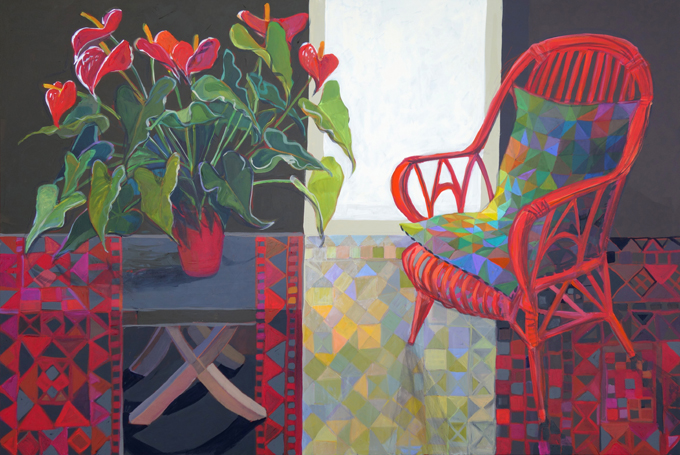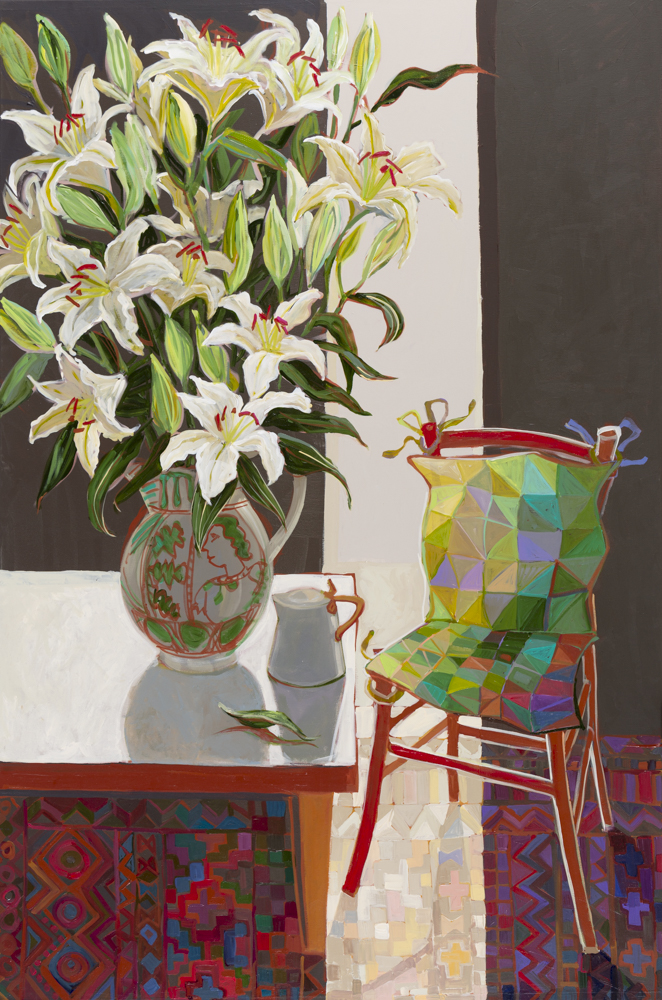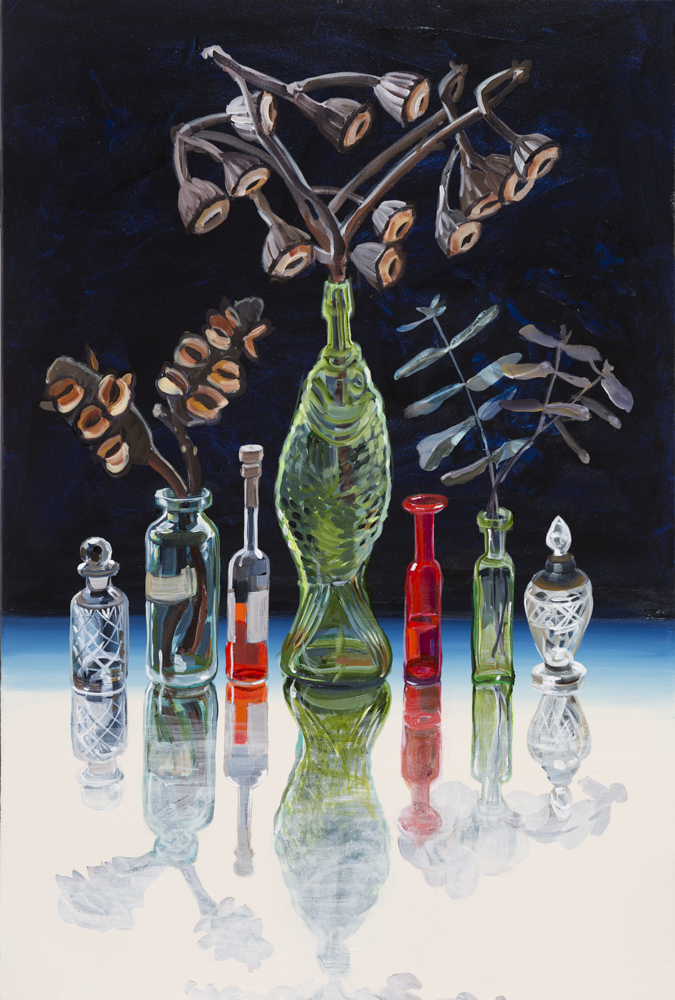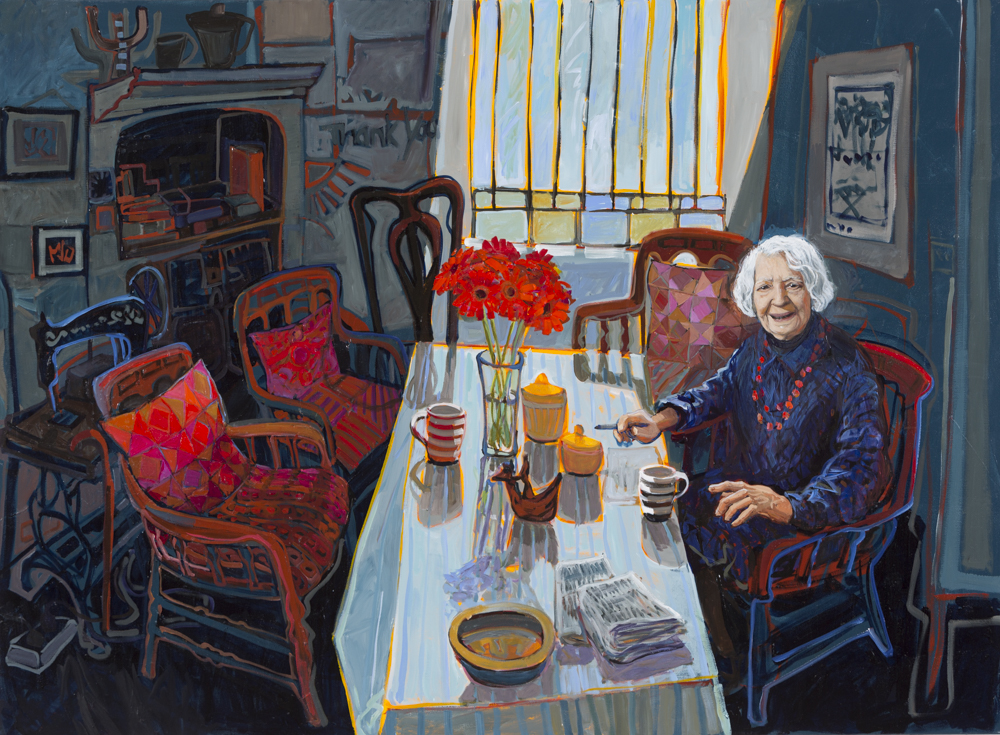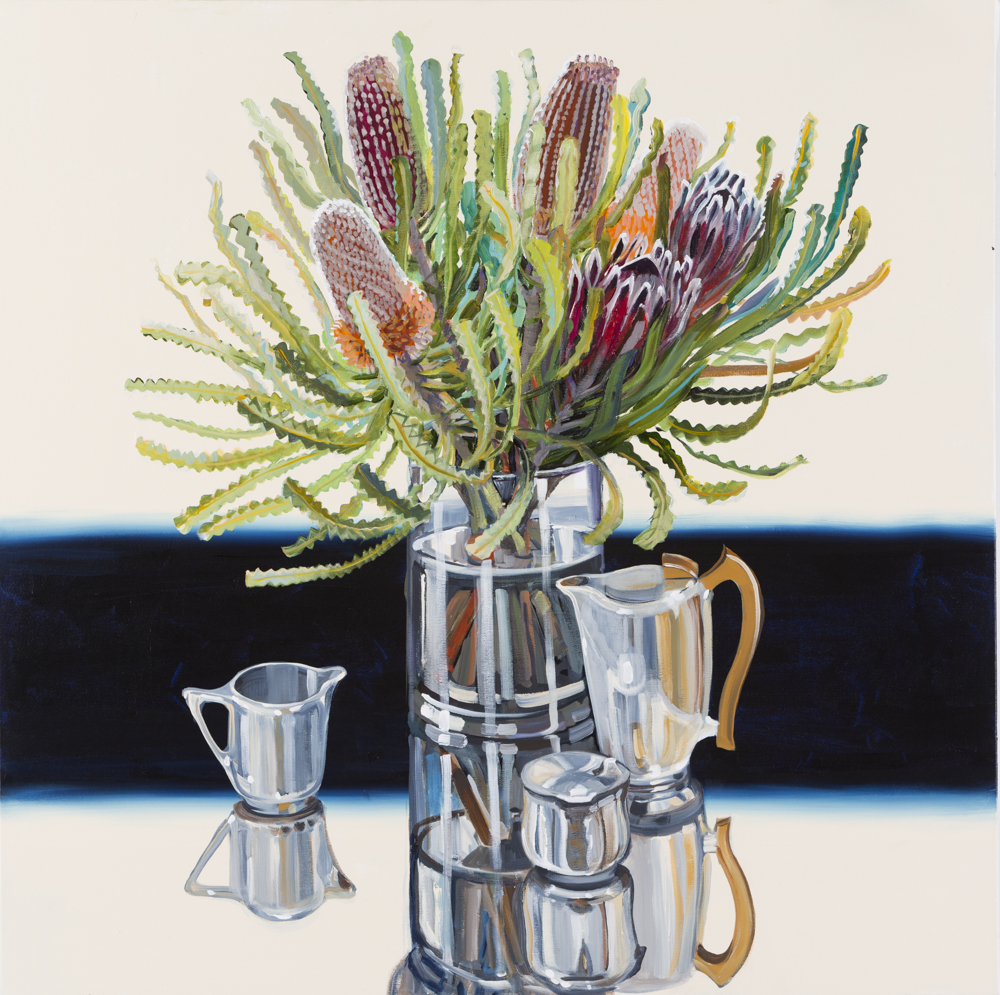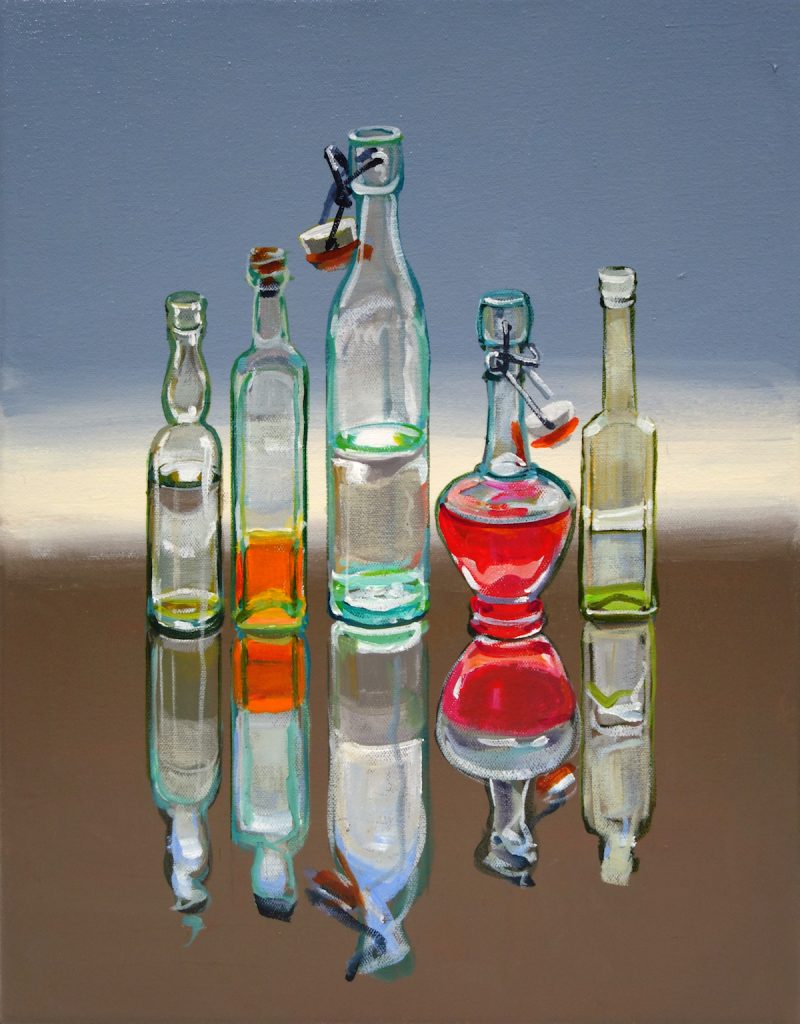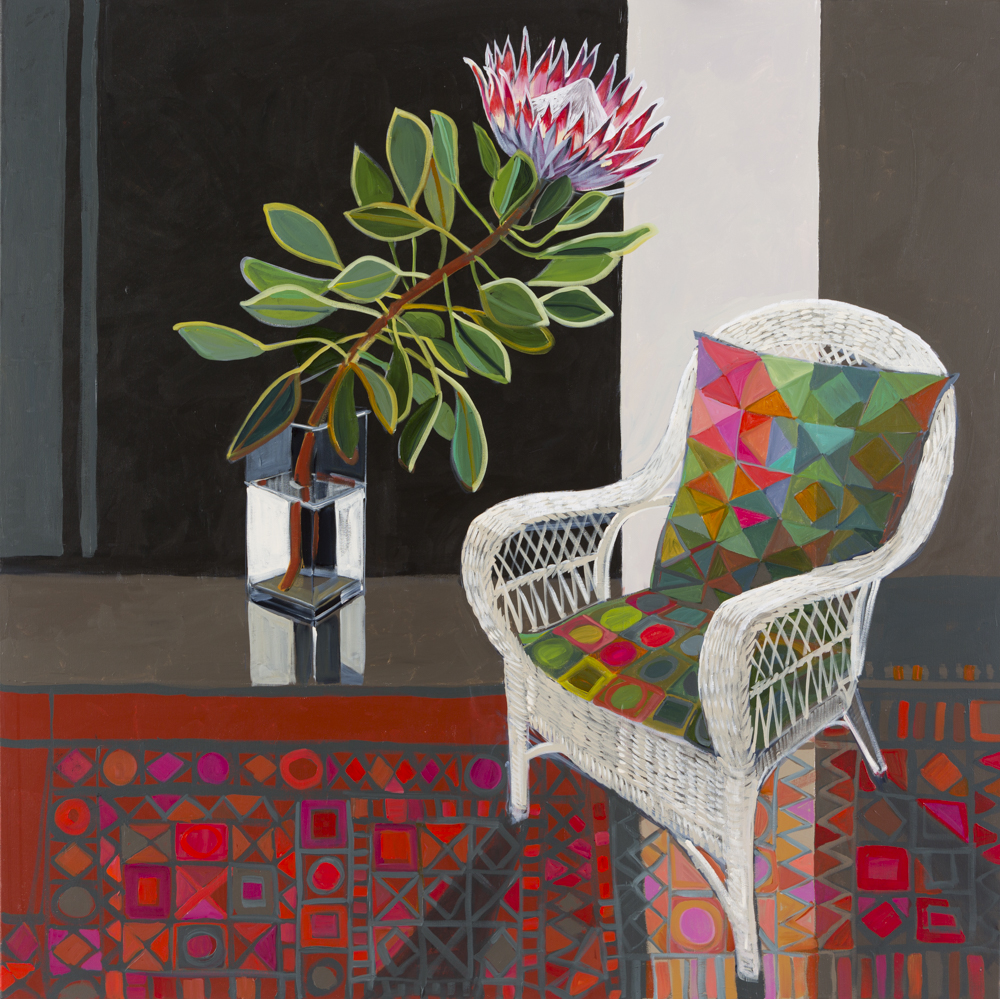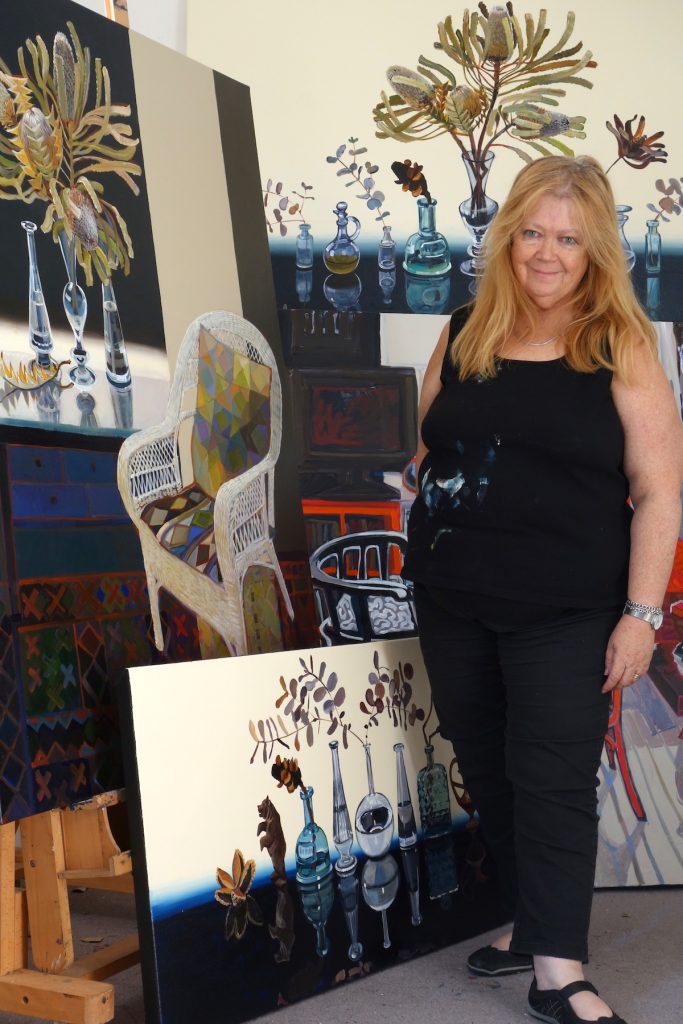Christine Webb Painter - Australia, Italy
“My art practice is a core part of who I am, an extension of my environment and the various places I embrace.” Expand on this statement in relationship to dividing your time in both Australia and Italy,
I moved to reside full time in Central Italy with my family in 2000 and since 2011 I have moved back to Australia. We still have our home there and now spend the four summer months there every year. It’s an upheaval moving between homes but one becomes very organised and adept at the changes. You notice differences that you might otherwise overlook. A shaft of light with dust mites caresses the floor of ancient red tiles.
Authurium Armchair, 150 x 100cm
The lurch between the two worlds is incredibly invigorating, the contrast ofold Europe and young Australia lifts your ability to embrace more of what you want in your work. I’ve had the wonderful advantage of visiting some of the most wonderful museums in the world and I can cherry pick from the best exhibitions, Australia and Europe has to offer.
Golden Summer, 137 x 107 cm.
Discuss the importance of personal objects in your current work?
I’ve accumulated many sentimental things through family and friends, travels and trolling through flea markets. Perhaps because I’m so unsettled as to where I live, I hold on to these talisman dragging them from studio to studio. They populate my work like old friends. An old wooden bear that’s been handed on in my family so that no one recalls where it came from. My mother had collected a strange primeval seed pod, another was given to me by friends. People give me old bottles and vases. Everything has a story
A Balance of Sorts, 36.5 x 35.5cm
Expand on the influence of Australian women artists in your work – Cowley, Cossington- Smith, Preston, Olley, and Beckett.
Influences of their work from the 1930’s onwards.
Influences of Australian flora in their work
Influence of place / home
This interesting, and often underrated group of women artists is fascinating to study. Most of them had travelled overseas and on return home, embraced the local fauna and landscapes. Margaret Preston also worked on magazines, as I have, Grace Cowley and Cossington-Smith were brilliant colourists, Clarice Beckett painted on the Mornington Peninsula where I lived and there she breathed an unparalleled atmosphere into her works. Margaret Olley is many people’s first reference point whenever they see a vase of Australian flowers, but it’s her delicate restraint in painting flannel flowers that strikes a chord with me. They all worked and worked incredibly hard, teaching and/or producing huge bodies of paintings struggling against a prevailing preference for the works by men.
Three Bottles with Flannel Flowers, 30.5 x 25.5cm
Discuss your thoughts on the role of home in both their work and yours as a woman painter?
Many women painters work in a home studio with constricted space. The dining table becomes the tableau with personal objects populating the space. For many years in Italy I was able to use my colourful jugs and fruit bowls to balance the market flowers.
Market Lillies, 150 x 100cm
In the confined space, being so close to the subject, the perspective skews in such a way that the table becomes a vertical plane leading the work to a graphic conclusion. I now find the intrusion of daily life is difficult to juggle and now I prefer to work in my studio either in the old garage in Italy or in my marvellous studio at One +2 in Lilyfield, Sydney.
Fly Away Peter, 61 x 91cm
How does the use of acrylic paint play an important part in both your work and your family life?
When I first painted at art school I developed an allergy to the solvents used in oil paint. Later I found that painting in the family home was easier with acrylic, less stink. Now after many years painting I’ve found it suits the speed that I like to work, the easy clean up, the quick drying. I like to resolve composition problems quickly and acrylic allows me to do this. I’ve worked up a method of under painting that results in a richness of colour that equals any medium.
Red Table, 137 x 37cm
Discuss the difference in light and colour between Australia and Italy and how you embrace both?
The difference in light and atmosphere is mainly noticeable in landscape works, but even in my interiors and still life there is a shift in light between the two places.
Nancy’s Table, 152 x 111cm
The centuries old Italian architecture creates shafts of light in largely poorly lit, wooden beamed rooms creating hard cast shadows, while in Australia the blaze of light bouncing off white walls and ceilings illuminates the shadows and you get the sense of this massive light.
Reflections of George, 91 x 91cm
You have just completed the works for your solo exhibitions ‘’On reflection”
I have become more obsessed with cast shadows and reflection over the years. I lived in Sorrento Victoria for several years and painted the waters of Port Phillip Bay and studied Turner. This was when the reflection on water first fascinated me. Then working in Italy the highly polished dark table where I set my tableau, gave wonderful reflections of the objects. On returning to Australia I commenced working on mirrored surfaces, creating a faux horizon that echoes the edge of the world which is where I feel I live, in two hemispheres.
Starfish Symmetry, 40 x 40cm
I struggle with titles of paintings and exhibitions but finally the double meaning of ‘On Reflection’ gelled immediately. There will be about 22 works hung in the show with another dozen in the wings. Most of the works have been done in the last seven months in Australia but several I painted in Italy, rolled up and re-stretched when I got back.
Discuss painting the combination of glass and water.
While I was in Italy I started placing the objects against the light of an open window, contrary to accepted practice. Solid objects became silhouettes unless they were lit with a fill light, but glass bottles became more brilliant and with an abundance of odd shaped oil and balsamic vinegar bottles, I found a new intrigue.
A Certain Symmetry, 30.5 x 45.5cm
Discuss other liquids you paint.
Clear water adds an interesting refraction, sometimes seeing the reflected image through the window inverted. Virgin olive oil has an exquisite range of warm greens and lime yellow while Campari and Aperol is fiery red. I also like painting green and deep blue glass but will half fill with water if I can to give an additional light refraction.
Five Extra Virgins, 60 x 60cm
Explain your use of composition in your work?
Table still life
I find that composition is my first consideration. If I don’t get that right, nothing I do will save the work. Part of my overall art practice has involved a lot of photography and composing through the lens has been a habit passed on from that work. In painting you can straighten verticals and horizons as you desire while in photographyit’s a struggle, so I prefer plumbed lines and straight horizontals.
Nancy’s Nasturtiums, 36.5 x 25.5cm
A friend observed a crucifix in one work with the objects arrayed like supplicants at the foot of the cross. As I set up a still life the space between the objects and their relation to each other is paramount. The negative spaces created and the overall shape against the background are all important steps in my decision making. I’m currently fascinated with a line up of objects creating a lozenge shaped oval in conjunction with their reflection.
Room still life
When I paint larger works of interiors I approach the work with a different process. I often develop drawings in situ in friend’s homes and develop a work referencing photos of details, patterns and textures. The resulting abstraction becomes a work of shape and design. Sometimes I set a chair against floral setting and echo the colourthough the cushions and stylised carpet.
Summer Bloom, 137 x 137cm
Explain briefly what you teach in your Colour Theory workshops?
I always loved creating colour wheels with a circle and compass as a kid and when I was at art school I had an excellent teacher. I’ve continued my study of the subject with John Gage’s massive tome: Colour and Culture and also had the advantage of seeing many of the original works of Van Gogh, Matisse and Picasso. A Manet exhibition I saw in Venice threw a new light on the marvellous darks of his paintings that don’t come across in reproductions. Caravaggio too, has to be seen for real to get the full impact of the deep darks.
While the colour wheel teaches us how to organise prismatic colour into limited palettes and ways of mixing neutrals, I also teach and demonstrate how each of the three colour attributes, Hue, Value and Chroma, can create balance and harmony in their own right.
Expand on the use of the colour wheel in your own work
A very common use of a limited pallet is to use two analogous hues such as green and blue and a complementary accent, in this case the orange of the banksia. The nuance of the colour is highlighted by the use of a cool neutral of the background and dazzling neutrals in the water. The wide range of values hold the symmetry of the composition.
Sorrento Banksia with Portsea Oil, 61 x 120cm
Discuss how you use shape in your work with bottles?
At the moment I’m playing with positive and negative shapes in a chiaroscuro way. An echo of some of Titian’s compositions where he placed a light figure on a dark interior background and balanced it with a dark figure against an open window and lighter landscape beyond. My interpretation of this work has a lighter bottle against a dark background casting a dark shadow reflection on the mirrored surface. I’m exaggerating what I can see for real with what I’m pursuing as a solution to a composition, corrupting the dialogue without disturbing the visual play.
Unrelated Memories, 120 x 80cms
Can you give us your impressions on how exhibitions give your work a new momentum?
I work in my studio as a full time job. As the far off deadline of an exhibition comes into focus so does the direction of the body of work. The pressure certainly creates some anxiety but I have pushed many life choices and I like to rise to a challenge. Exhibitions offer the ability to view a body of work in a new environment, presented outside the confines and chaos of the studio. Despite the anxiety that exhibitions cause, it is a moment to cherish. Several years ago I hired an artist’s run space at Danks Street and minded the show for two weeks. It was a treat to be surrounded by my work and hear what people had to say. Thank heaven it was all positive. It’s an important part of the visual growth of the work, what I can see clearly works well informs the next stage of my work. Throw away comments, more often than not, focus my attention on how people read a painting, what they see. Hopefully they see a connection or feel a calming influence that they enjoy.
Contact details.
Christine Webb
christinemariuswebb@gmail.com
www.christinewebb.com
Represented in Australia by Katrina Hampton at Art2Muse
Christine Webb, Australia & Italy
Interview by Deborah Blakeley, May, 2016
Think a colleague or friend could benefit from this interview?
Knowledge is one of the biggest assets in any business. So why not forward this on to your friends and colleagues so they too can start taking advantage of the insightful information the artist has given?
Other artists you may be interested in:



